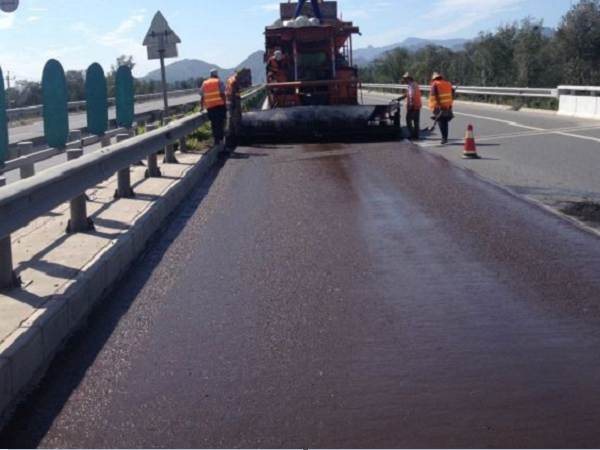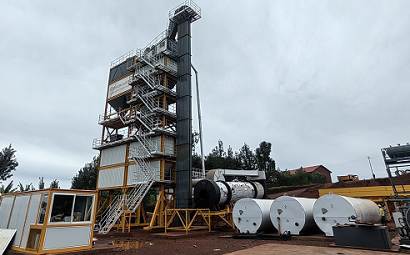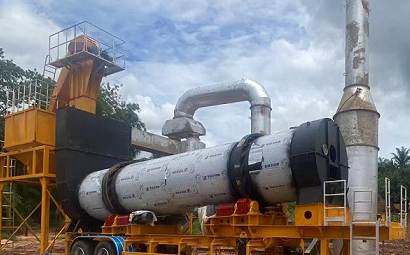The editor of the asphalt mixing plant will introduce the types of asphalt modifiers:
With the development of the national economy, the traffic volume is getting larger and larger, the vehicle load is getting heavier, and the temperature is gradually warming up. Heavy traffic road asphalt can no longer meet the use requirements of high-grade highways and special sections. In order to improve the road surface's resistance to permanent deformation, rutting, bumping, displacement, fatigue, low-temperature cracking, aging, and water damage, the research and application departments of asphalt materials have proposed to modify road asphalt to improve the overall function of asphalt materials.

The so-called modified asphalt is to add appropriate and appropriate modifiers (one or more) to the base asphalt to improve or improve certain functions of asphalt and meet the process or method of road use requirements.
⒈Thermoplastic plastics: polyethylene PE, EVA, etc.;
⒉Thermosetting plastics: phenolic resin, epoxy resin, etc.;
⒊Rubber: natural rubber NR, SBR, CR, BR, IIR, etc.;
⒋Thermoplastic elastomers: SBS, SIS, SEBS, etc.;
⒌Natural asphalt: lake asphalt, rock asphalt, etc.
Thermoplastic elastomer SBS has good compatibility and storage stability with asphalt, and has good high temperature and low temperature functions; SBS is the most widely used asphalt modifier at home and abroad.
SBS is a thermoplastic elastomer, which is a linear or star-shaped block copolymer obtained by anionic polymerization with butadiene and styrene as monomers, cyclohexane as solvent, n-butyl lithium as initiator, tetrahydrofuran as activator. The SBS polymer chain has different blocks of series structure, namely plastic segment and rubber segment, forming an alloy-like structure. Due to this common structure, it has both the rigidity and plasticity of plastic and the flexibility and elasticity of rubber.
 Albanian
Albanian  Russian
Russian  Arabic
Arabic  Amharic
Amharic  Azerbaijani
Azerbaijani  Irish
Irish  Estonian
Estonian  Odia (Oriya)
Odia (Oriya)  Basque
Basque  Belarusian
Belarusian  Bulgarian
Bulgarian  Icelandic
Icelandic  Polish
Polish  Bosnian
Bosnian  Persian
Persian  Afrikaans
Afrikaans  Tatar
Tatar  Danish
Danish  German
German  French
French  Filipino
Filipino  Finnish
Finnish  Frisian
Frisian  Khmer
Khmer  Georgian
Georgian  Gujarati
Gujarati  Kazakh
Kazakh  Haitian Creole
Haitian Creole  Korean
Korean  Hausa
Hausa  Dutch
Dutch  Kyrgyz
Kyrgyz  Galician
Galician  Catalan
Catalan  Czech
Czech  Kannada
Kannada  Corsican
Corsican  Croatian
Croatian  Kurdish (Kurmanji)
Kurdish (Kurmanji)  Latin
Latin  Latvian
Latvian  Lao
Lao  Lithuanian
Lithuanian  Luxembourgish
Luxembourgish  Kinyarwanda
Kinyarwanda  Romanian
Romanian  Malagasy
Malagasy  Maltese
Maltese  Marathi
Marathi  Malayalam
Malayalam  Malay
Malay  Macedonian
Macedonian  Maori
Maori  Mongolian
Mongolian  Bengali
Bengali  Myanmar (Burmese)
Myanmar (Burmese)  Hmong
Hmong  Xhosa
Xhosa  Zulu
Zulu  Nepali
Nepali  Norwegian
Norwegian  Punjabi
Punjabi  Portuguese
Portuguese  Pashto
Pashto  Chichewa
Chichewa  Japanese
Japanese  Swedish
Swedish  Samoan
Samoan  Serbian
Serbian  Sesotho
Sesotho  Sinhala
Sinhala  Esperanto
Esperanto  Slovak
Slovak  Slovenian
Slovenian  Swahili
Swahili  Scots Gaelic
Scots Gaelic  Cebuano
Cebuano  Somali
Somali  Tajik
Tajik  Telugu
Telugu  Tamil
Tamil  Thai
Thai  Turkish
Turkish  Turkmen
Turkmen  Welsh
Welsh  Uyghur
Uyghur  Urdu
Urdu  Ukrainian
Ukrainian  Uzbek
Uzbek  Spanish
Spanish  Hebrew
Hebrew  Greek
Greek  Hawaiian
Hawaiian  Sindhi
Sindhi  Hungarian
Hungarian  Shona
Shona  Armenian
Armenian  Igbo
Igbo  Italian
Italian  Yiddish
Yiddish  Hindi
Hindi  Sundanese
Sundanese  Indonesian
Indonesian  Javanese
Javanese  Yoruba
Yoruba  Vietnamese
Vietnamese  Hebrew
Hebrew  Chinese (Simplified)
Chinese (Simplified)






